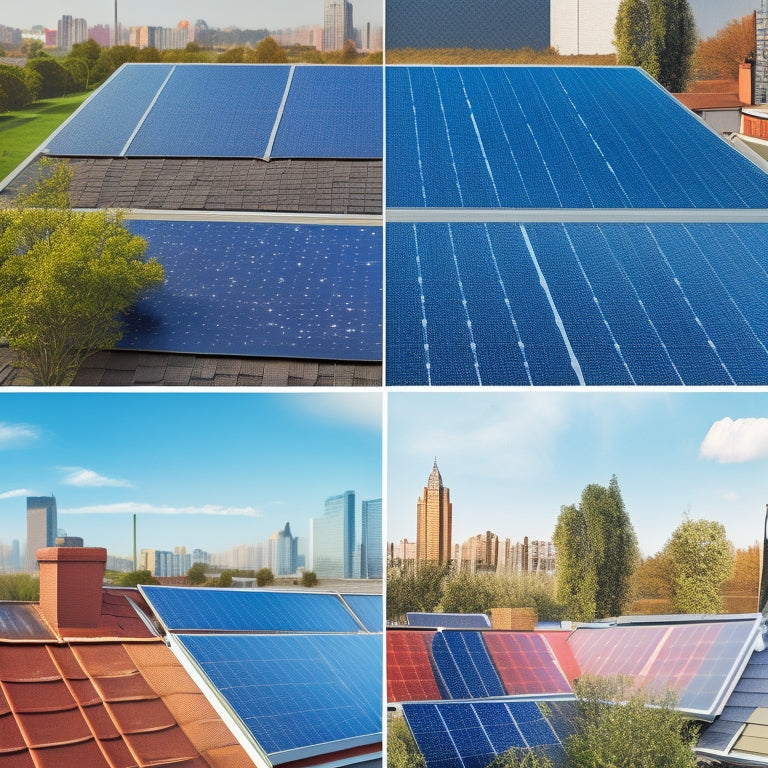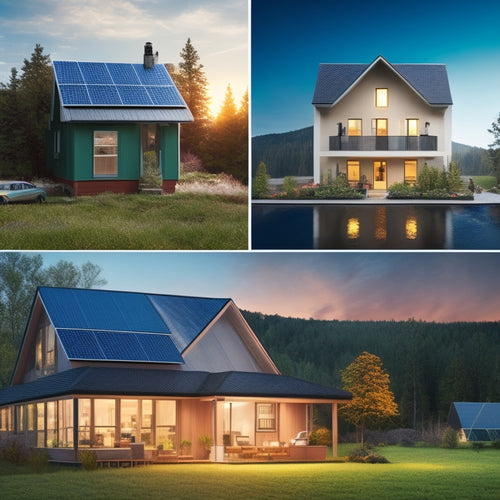
Why Maintain Your Cool Roof for Peak Performance?
Share
You've invested in a cool roof to reduce energy costs and minimize your environmental footprint, but its performance is only as good as its maintenance. To maintain peak performance, you should schedule regular inspections to check for wear and tear, cracks, and fading. Clean debris and dirt regularly, and inspect sealants and caulk for damage. Guarantee proper drainage, verify reflectivity levels, and trim nearby vegetation to prevent shading effects. By performing repairs promptly and documenting maintenance records, you'll prevent major problems, reduce energy consumption, and extend the roof's lifespan. Now, take the next step to reveal the full potential of your cool roof.
Key Takeaways
- Regular maintenance ensures optimal energy efficiency and reduces energy consumption by identifying and addressing issues early.
- Proper maintenance prevents water accumulation, ponding, and leaks, which can lead to premature aging and damage to the roof.
- Regular inspections and cleaning help maintain the roof's reflectivity, reducing the urban heat island effect and supporting eco-friendly practices.
- Timely repairs and maintenance prevent minor issues from escalating into major problems, reducing costs and ensuring structural integrity.
- Accurate documentation and record-keeping enable tracking of performance, pattern identification, and issue troubleshooting, ensuring compliance and peace of mind.
Schedule Regular Inspections
Every six months, inspect your cool roof to guarantee it continues performing at its best.
Regular inspections are vital to maintaining your roof's energy efficiency and extending its lifespan. You'll want to check for signs of wear and tear, such as cracks, blisters, or fading, which can compromise your roof's ability to reflect sunlight and heat.
In addition, inspect the roof's membrane for any damage or deterioration. By catching these issues early, you can address them before they become major problems, ensuring your cool roof remains a beneficial asset in reducing your energy consumption and costs.
Moreover, it's important to evaluate implementing sustainable practices, such as renewable energy sources, to maximize your roof's eco-friendly benefits.
Stay on top of inspections to keep your roof running smoothly and efficiently, giving you the freedom to enjoy the benefits of a cool roof.
Clean Debris and Dirt
You'll want to remove loose debris like leaves and branches from your cool roof regularly to prevent damage and guarantee peak performance.
Regular cleaning is especially important for commercial properties with EV charging stations, as fast charging infrastructure requires efficient energy use to minimize downtime for EV drivers.
Next, you should regularly hose down the roof to wash away dirt and other substances that can compromise its reflective properties.
After cleaning, inspect the roof for stains or signs of wear, addressing any issues promptly to prevent them from becoming major problems.
Remove Loose Debris
The roof's surface must be clear of loose debris to guarantee effective cool roof performance and prevent damage.
You'll want to remove loose debris like twigs, leaves, and other obstructions that can compromise your cool roof's ability to reflect sunlight and heat.
As part of your seasonal maintenance, set aside time for debris collection. Regularly clearing your roof's surface guarantees that your cool roof can function at its best, much like how the trucking industry can benefit from solar energy solutions to reduce their carbon footprint.
Additionally, a clean roof surface can lead to increased energy efficiency, similar to how solar energy can drastically reduce energy expenditures for trucking companies.
Failure to do so can lead to reduced energy efficiency, increased energy bills, and even premature wear.
Regularly Hose Down
Regular cleaning of your cool roof's surface is essential to maintain its effectiveness.
You'll want to regularly hose down your roof to remove dirt and debris that can reduce its energy efficiency. A dirty roof can lead to increased energy consumption, which not only increases your energy bills but also reduces the roof's lifespan.
By hosing down your roof, you'll be able to maintain its reflective properties, ensuring it continues to reflect sunlight and heat away from your building. This simple maintenance task will help you save money on energy costs and extend the life of your roof.
Additionally, adopting sustainable practices like renewable energy solutions can also contribute to a cleaner environment.
Inspect for Stains
Inspecting your cool roof for stains is an essential maintenance task that helps identify areas where dirt and debris have accumulated, compromising its energy efficiency.
You'll want to check for various stain types, including organic stains from plant growth, rust stains from metal components, and oil-based stains from roof coatings.
The inspection frequency will depend on your roof's location, usage, and climate. As a general rule, inspect your roof every 6-12 months, or more frequently in areas with high pollution or heavy vegetation.
Look for signs of staining, such as discoloration, dark spots, or uneven reflectivity. Regularly monitoring solar panel performance metrics can also help identify potential issues before they affect your roof's performance.
Similarly, ensuring proper electrical safety checks can prevent hazards and maintain a safe and efficient system.
Inspect Sealants and Caulk
Every few months, you should examine the sealants and caulk on your cool roof for signs of wear, damage, or deterioration.
Check for cracks, gaps, or softening in the sealants, as these can compromise the roof's waterproofing. Ascertain that all sealant types, including silicone, polyurethane, and acrylic, are still effective and not showing signs of aging.
Inspect caulk applications around vents, skylights, and other roof penetrations, verifying that they remain securely bonded to the substrate.
Look for signs of shrinkage, pulling away from the surface, or discoloration, which can indicate a loss of adhesion.
Check for Ponding Water
When checking for ponding water, you'll want to inspect flat areas on your roof where water tends to collect, such as around HVAC units, skylights, and roof vents.
You should also examine your roof's drainage system to verify it's functioning properly and not clogged.
Be on the lookout for signs of water accumulation, including rust, corrosion, or mineral deposits, which can indicate where water is pooling.
Flat Areas to Inspect
Many flat areas on your cool roof are prone to ponding water, which can lead to premature aging and damage. As you inspect these areas, pay attention to the spots where water tends to collect.
This is especially important in areas with low sunlight exposure, as the reduced temperature regulation can exacerbate water accumulation.
Inspect these flat areas closely for signs of ponding water:
-
Roof valleys: Where two slopes of the roof meet, creating a valley that can collect water.
-
Low-lying areas: Spots on the roof that are lower than the surrounding areas, creating a natural collection point for water.
-
Areas around skylights or vents: Water can accumulate around these roof penetrations, leading to damage and premature aging.
Roof Drainage System Check
As you've identified areas prone to ponding water, it's now important to guarantee your roof's drainage system is functioning properly to alleviate this issue.
You should inspect the drainage system's components, such as gutters, downspouts, and scuppers, for blockages, sagging, or damage. Ascertain they're securely fastened and properly sloped to facilitate water flow.
Check for signs of rust, corrosion, or deterioration that could impede water flow. Effective maintenance techniques include regular cleaning, debris removal, and confirming a clear path for water to flow freely.
A well-maintained drainage system is essential to prevent water accumulation, which can lead to damage, leaks, and compromised roof performance.
Water Accumulation Signs
One essential aspect of cool roof maintenance is identifying signs of water accumulation, particularly ponding water, which can lead to severe damage if left unchecked.
You need to be vigilant in spotting these signs to prevent water damage and guarantee effective moisture control.
Here are some common signs of water accumulation to watch out for:
-
Visible water ponds: If you notice water pooling on your roof, it's a clear indication of ponding water.
-
Water stains or discoloration: Check for water stains or discoloration on your roof's surface, which can indicate water seepage or accumulation.
-
Rust or corrosion: Look for signs of rust or corrosion on metal components, such as flashing, vents, or skylights, which can be caused by water accumulation.
Perform Repairs Promptly
By neglecting to address cool roof damage, you risk escalating minor issues into major problems that compromise the entire system.
Prompt repairs are essential to maintaining your cool roof's performance and integrity. When you identify damage, don't hesitate to apply effective repair techniques using suitable repair materials.
This proactive approach guarantees that your roof continues to reflect sunlight, reduce energy consumption, and provide a comfortable indoor environment.
Failing to address cracks, blisters, or punctures can lead to water infiltration, structural weaknesses, and even roof collapse.
Take control of your roof's maintenance, and you'll enjoy the freedom to focus on more important aspects of your life, knowing your roof is secure and performing at its best.
Ensure Proper Drainage
The roof's drainage system plays a critical role in maintaining a cool roof's performance and longevity. You must guarantee that water flows freely and doesn't accumulate on the surface. Clogged drains and gutters can lead to water seepage, reducing the roof's energy efficiency and causing structural damage.
To guarantee proper drainage, check the following:
-
Clear debris: Regularly remove leaves, twigs, and other obstructions from gutters and downspouts to maintain unimpeded water flow.
-
Inspect drainage systems: Verify that drainage systems are functioning correctly, and make repairs or replacements as needed.
-
Check slope and angle: Confirm the roof's slope and angle allow water to flow freely towards the drainage system, preventing puddles and water accumulation.
Verify Reflectivity Levels
Your cool roof's reflectivity levels directly impact its energy efficiency and overall performance. As a building owner, it's crucial to verify these levels regularly to guarantee ideal results.
Conducting regular reflectivity testing helps you identify any degradation in your roof's reflective properties. This proactive approach enables you to take corrective measures before your roof's performance suffers.
Performance monitoring is critical, as even slight decreases in reflectivity can lead to increased energy consumption and costs. By staying on top of reflectivity testing, you'll be able to maintain your cool roof's peak performance, keeping your energy bills in check and your building comfortable and efficient.
Trim Nearby Vegetation
Clear nearby vegetation to prevent it from overgrowing and compromising your cool roof's performance. Overgrown vegetation can cast shade on your roof, reducing its reflectivity and increasing the temperature of your building.
This not only negates the benefits of your cool roof but also increases your energy consumption.
To maintain peak performance, you should:
- Regularly inspect your roof's surroundings to identify potential vegetation growth.
- Implement shade management strategies, such as pruning or removing trees and plants, to minimize shade.
- Develop a vegetation control plan to prevent future overgrowth and guarantee your cool roof continues to perform at its best.
Document Maintenance Records
Proper documentation is key to ensuring your cool roof's maintenance history remains transparent and accessible.
You'll want to keep detailed records of all maintenance activities, including dates, tasks performed, and materials used. This documentation importance can't be overstated, as it provides a clear trail of your roof's maintenance benefits.
By keeping accurate records, you'll be able to identify patterns, track progress, and make informed decisions about future maintenance needs. Additionally, having a paper trail can help you troubleshoot issues, resolve disputes, and even provide proof of compliance with building codes and regulations.
Take the time to document your maintenance records, and you'll reap the rewards of a well-maintained cool roof that performs at its best.
Frequently Asked Questions
Can I Maintain My Cool Roof Myself or Do I Need a Professional?
You can attempt DIY maintenance, but for ideal results, consider hiring a professional for tasks like coating inspections and repairs, as they possess the knowledge and equipment to guarantee your cool roof operates at its best.
How Often Should I Inspect My Cool Roof for Optimal Performance?
You're probably not thinking about your cool roof until it's blazing hot outside, but you should! Inspect your roof at least twice a year, and consider seasonal maintenance tips to guarantee peak performance and energy efficiency.
Are Cool Roofs More Prone to Damage From Extreme Weather Conditions?
You're right to wonder: are cool roofs more prone to damage from extreme weather conditions? The answer is, not necessarily. While extreme weather impacts can be intense, a well-maintained cool roof's durability is designed to withstand them, ensuring your freedom from costly repairs.
Can I Use Any Cleaning Products on My Cool Roof or Are There Restrictions?
You'll be surprised to know that not all cleaning products are created equal for your cool roof! You'll need to opt for gentle, non-abrasive cleaning methods and product recommendations specifically designed for cool roofs to avoid damaging the reflective coating.
Do Cool Roofs Require More Maintenance Than Traditional Roofs?
You'll find that cool roofs don't necessarily require more maintenance than traditional ones, but regular upkeep is essential to guarantee cool roof longevity and minimize maintenance costs; neglecting it can lead to premature degradation.
Related Posts
-

What Does Your Home Energy Audit Report Reveal?
Your home energy audit report reveals a detailed analysis of your energy consumption patterns, highlighting areas of ...
-

5 Ways Geothermal Power Boosts Electric Vehicle Efficiency
You're likely unaware that geothermal power can greatly enhance your electric vehicle's (EV's) performance, range, an...
-

Why Grow Up? Vertical Gardens Transform Urban Living
As you change your urban living space, you're not just growing up - you're bringing nature back into the heart of the...


